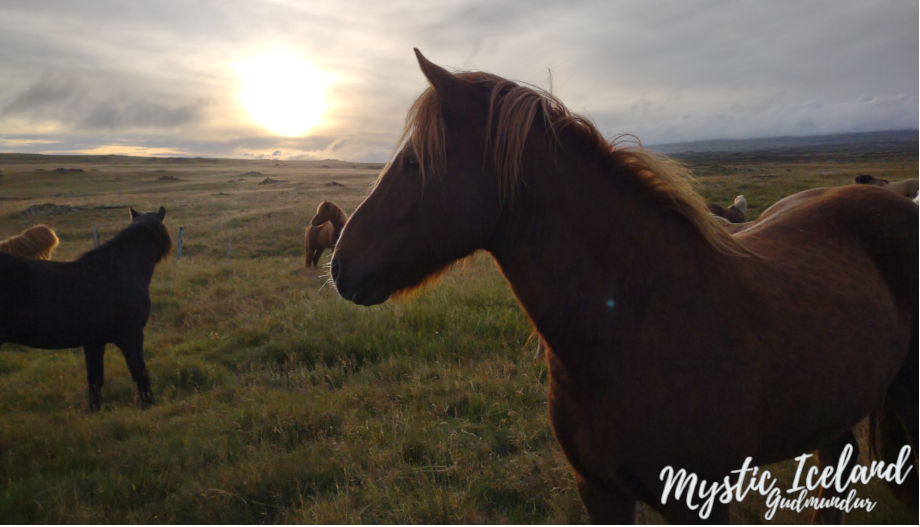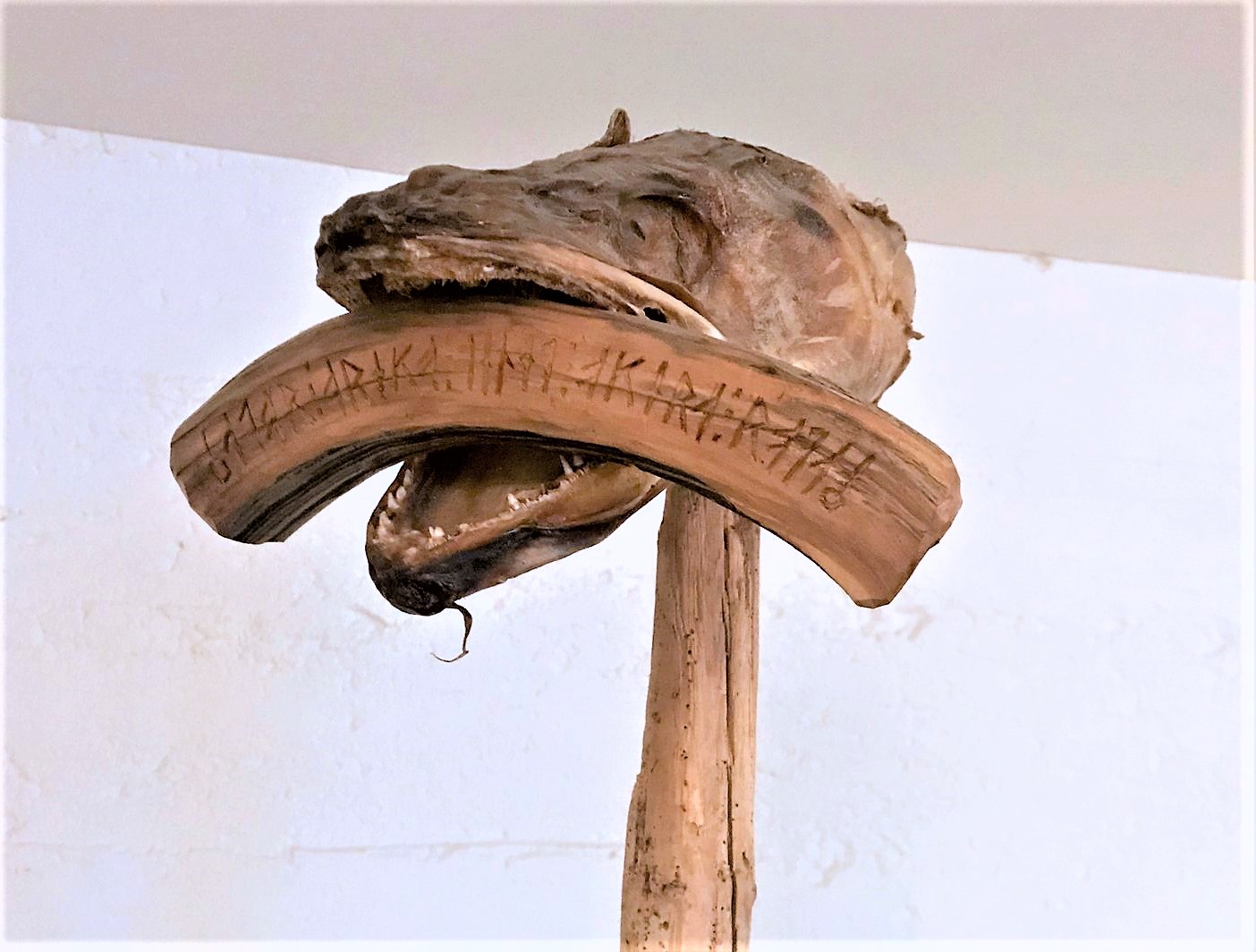It’s 1668 and the seizure hysteria was flaring back up again. With Margrét out of the picture the people continued pointing their fingers at suspecting sorcerers. Therefore, it was time to figure out who was executing black magic spells this time.
Accusations
Photo: Norðurfjörður, the location of the farmstead that Sigmundur took over from Eyjólfur.
Back in Trékyllisvík, the neighbors Sigmundur Valgarðsson and Eyjólfur Jónsson had been feuding over the land ownership for quite some time. On May 22nd, 1669, Sigmundur decided to level up his battle tactics by attending the Thing in Árnes and charge Eyjólfur with witchcraft. Incidentally, Sigmundur had recently fallen ill and the people were looking for a sorcerer to blame for the hysteria. With this in mind, Sigmundur used this perfect opportunity to point the finger at Eyjólfur’s magic.
Under those circumstances, Sigmundur told the lawmen about an incident four years ago when he had taken the Norðurfjörður farmstead from Eyjólfur. This transfer of property didn’t go as smooth as he had hoped. As a result, Eyjólfur despised him and used every opportunity to take him down.
For this reason, there was nothing stopping Sigmundur. This was his golden opportunity so, he told the lawmen that he wasn’t the only one to fall victim to Eyjólfur’s sorcery. As a matter of fact, a farmer in Staðarhreppur by the name of Böðvar Ketilsson (1628-?) lost one of his calves as a result of Eyjólfur executing black magic spells on him.
At the Thing

These were serious accusations therefore, the authorities felt they needed to look into it deeper. The two men, Sigmundur and Eyjólfur were to appear at the Thing in Árnes in two days. All the county officials showed up for the hearing and above all, so did several witnesses.
Unfortunately, Böðvar wasn’t present at the hearing to confirm the claim about his dead cow,. On the other hand, two other witnesses Jón Ísleifsson and Jón Ólafsson showed up. Eyjólfur watched as the vicar Guðmundur Bjarnason and other members of his vicarage stood up to testify. But, as they stood there before the authorities, they knew their words could put a man to death. Under these circumstances, they reluctantly admitted to hearing rumors about Eyjólfur executing black magic spells.
Wanting to know the reliability of the accuser, the panel of judges asked Eyjólfur’s neighbors what they thought of him. It was apparent that a few of them sided with Sigmundur and therefore accused him of performing dark witchcraft.
Witnesses

The lawmen called one witness after the other. Consequently, a farmer named Helgi Gunnarsson from Stórafell (now called Fell) farm volunteered as a witness. And so, Helgi continued to tell the lawmakers that right after Christmas couple of years back, he was getting ready for church. It so happened that Sigmundur was staying with him and when he heard Helgi was heading to church he got a strange look on his face.
Helgi couldn’t help but notice Sigmundur’s odd facial expression in so much that he had to know what was wrong. Nevertheless, Helgi didn’t get a straight answer but instead Sigmundur told him to stop at a farm north of the bay on the trail between Fell and Árnes. With this in mind, Helgi closed the door behind him and went on his way.
At the farm

Helgi couldn’t get the strange request out of his mind so, when he neared the farmstead that Sigmundur described, he knocked on the door. The door opened and a friendly face invited him inside. Helgi walked the dark narrow hallway into the baðstofa and sat down. Once he sat down he saw a black globe rolling on the floor. It was as if it appeared out of nowhere. He watched it grow bigger and bigger. In fact, it grew so big that it overwhelmed him to the point he started breathing rapidly, shaking and shivering covered in sweat. As a final point, he lost all his strength in so much that he had to be carried into bed. Even more, he had been sick ever since. Surely this was the work of Sigmundur executing black magic spells.
The lawmen looked over to the priest and his vicarage and they all confirmed that the story was true.
Hysteria

Afterwards, a farmer named Jón Oddsson from Krossnes said that Sigmundur had asked if he could keep one of his cows at Krossnes. So, Jón agreed to help him out. However, soon after he received the cow both Jón’s wife and sister became gravely ill. Not to mention intense shaking and quivering with hysteria, very much like what happened to Helgi.
In other words, the illness had spread out to the nearby homesteads and they all blamed Sigmundur and his witchcraft for having caused it.
And still, more witnesses came forward. One such witness was a man by the name of Grímur Þórðarson from Munaðarnes. He claimed that he had a relationship with a woman who lived with Sigmundur and ever since, Sigmundur had held a grudge against him. As a result of this, later that fall, one of Grímur’s sheep and one of his cows suddenly dropped dead. Sigmundur with a big smirk on his face had told him it was due to impure spirits. Surely this was a work of Sigmundur executing black magic spells.
The oaths
Harold Godwinson swearing oath on holy relics to William, Duke of Normandy
Sigmundur knew he was in danger of suffering the same fate as Eyjólfur. With this in mind, he begged to be released by the oath of compurgation. Fortunately, the judges agreed and as a result, 12 men were chosen to testify to the truthfulness of the oath. This meant that he needed seven random individuals to support his testimony and four individuals of his own choosing. Granted that he’d have the support by September 1669 when the next meeting at Árnes would take place.
Afterwards, it was Eyjólfur’s turn and this time the farmer named Böðvar was present. He could finally give his testimony and it wasn’t looking good for Eyjólfur. In fact, it was so dark that the judges found Böðvar’s accusations quite sinister when it came to the killing of the calf. Above all, they found the tone of his voice was quite ominous and exaggerated when he mentioned Eyjólfur’s witchcraft. As a result, the lawmakers told to cleanse himself with the Oath of compurgation (tylftareiðr).
Back home both Sigmundur and Eyjólfur worked on hard their oaths. However, it seemed their fate was being sealed. Consequently, the two men desperately and in panic begged the 12 chosen ones to sign their oath. As a final point, all 12 individuals refused to sign it. Even more, they were ready to swear to the courts that the two men were guilty of witchcraft. Under those circumstances, it was clear they believed the accused were executing black magic spells.
So, when the following summer (1670) came the two men were brought back to the Althing. However, this time they were brought back as prisoners charged with witchcraft. After reviewing the case again, the lawmen Þorleifur Kortsson (1615-1698) and Sigurður Björnsson named six men for each judgment panel.
Verdict

Þingvellir National Park was one of the Thing locations in Iceland. Árnesþing was another one. It was located in Árnes, west of Búði (Búðafoss).
In Sigmundur’s case the verdict was:
Consequently, later that day at the Thing Sigmundur received his whippings. Afterwards, the lawmakers called on Eyjólfur. In all honesty, the lawmakers had no desire to put him to death either. So, they searched through the Law of Moses (Mosaic Law) and all other law books they could get their hands on to find an alternative punishment. However, their hopes were quickly shattered.
Instead, they sought the help of the king’s representative, Jens Rodsteen (1633-1706) who was at the Althing. In contrast to what the lawmakers feared, Jens was able to put their minds at ease. To sum up, after consulting with Jens they finally had a reasonable punishment for Eyjólfur. With much relief, he only received three whippings. Nevertheless, these blows were to be as severe as possible. Sheriffs Magnús Jónsson and Vilhjálmur Arnfinnsson were to oversee the whippings.






